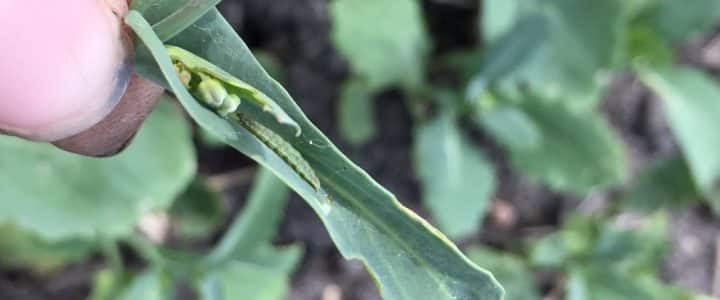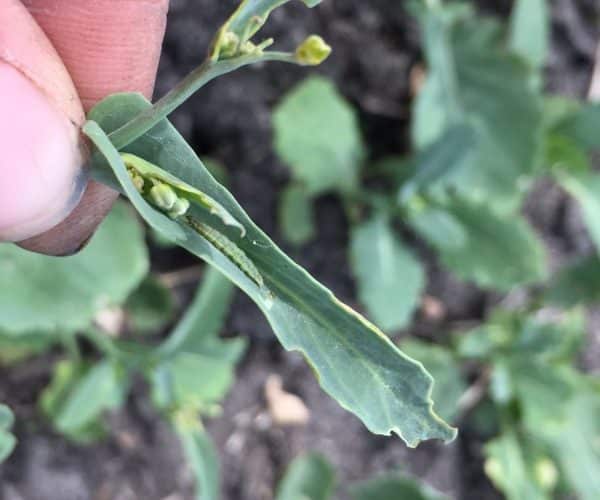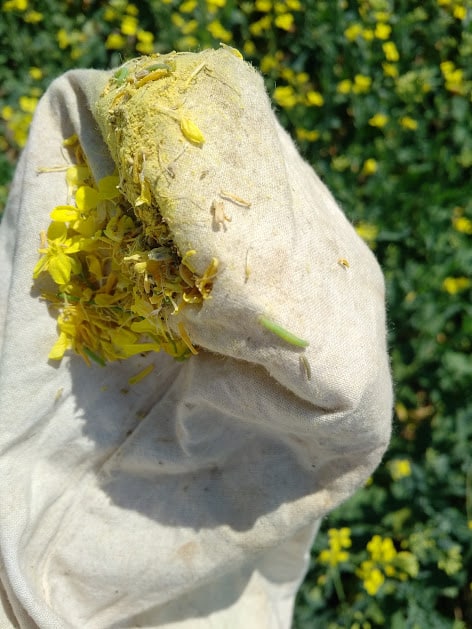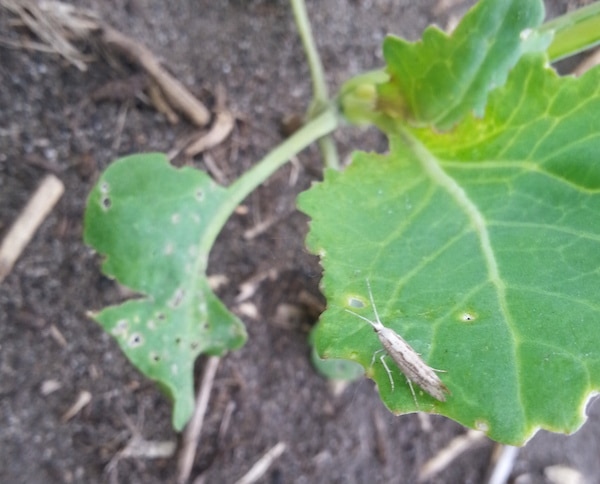Insect pests can easily gain interest in years when populations are higher and more damage is being caused to crops. However, understanding the factors contributing to lower populations may be just as important, since manageable populations are the scenarios that growers would prefer to maintain. This article considers some of the parameters which contribute to diamondback moth populations in canola in the Prairies.
Diamondback moth predictions
Diamondback moths are a common pest of canola, which feed on green canola plant tissue in their larval stage. As adults, they feed on the nectar of flowers (which causes no damage). However, the adults are actually present before the larvae. This is because diamondback moth adults utilize wind currents to migrate up to Canada in the spring. For this reason, wind trajectories are monitored as a way of predicting populations. Read more on this and see related maps from the Prairie Pest Monitoring Network.
Once on the Prairies, diamondback moths will lay eggs. The larvae that emerge from those eggs will begin feeding on various brassicaeous plants, such as mustard and canola. They can remain for up to four generations, which can overlap in their four life stages (egg, larva, pupa and adult). Modelled diamondback moth generation maps (such as the one pictured) can be found on the Prairie Pest Monitoring Network.
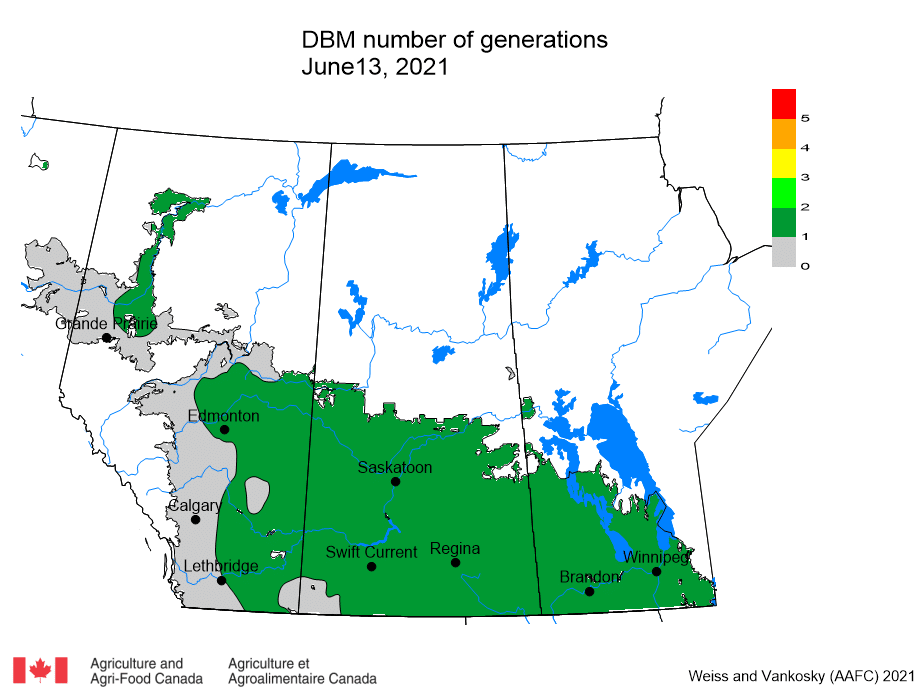
Source: Prairie Pest Monitoring Network
Several investigative projects have been conducted in the Canadian Prairies to better understand these pest insects, in order to better manage them in the field. Some of the interesting results which have grower management applications are described below.
Exciting parasitoid discovery
Dosdall’s research involved surveys in Alberta and Saskatchewan (in 2010-2012) of this pest insect and parasitoids which attack it. They found that the main parasitoid species attacking diamondback moth on the Prairies are Diadegma insulare, Microplitis plutellae, Diadromus subtilicornis, and Cotesia sp., believed to be Cotesia vestalis (of the family Braconidae). The discovery of this Cotesia parasitoid was exciting, especially since this species appeared to be responsible for a substantial level of the total parasitism of diamondback moth.
To see the life cycle of a typical braconid wasp (a wasp from the family Braconidae, such as Microplitis plutellae or Cotesia vestalis) interacting with canola, check out this CCC illustration.
Environmental requirements and limitations
Regarding habitat, it was proposed that growing season temperatures in North America are not limiting factors for the development of either diamondback moth or the parasitoid D. insulare, based on findings from Soroka’s research.
Laboratory studies in this project revealed lower and upper threshold temperatures for the development of diamondback moth to be 2.1 and 38.0°C, and of D. insulare (an ichneumonid wasp and the principal parasitoid of diamondback moth) to be 2.1 and 34.0°C, according to the model used. The low temperature threshold for diamondback moth development was lower than previously determined.
The paper published on this study also stated that using the Degree Day model, diamondback moth needed 143 d above 4.23°C to complete it’s life cycle, while D. insulare needed 286 d above 2.57°C.
Improved diamondback moth scouting tips
- Canola fields vary considerably in the densities of diamondback moth and the number (between 5-96% in this study) and species of parasitoids – even in the same year and among fields in the same geographical region. Therefore, it is very important for growers to carefully monitor populations of both the pest and beneficial insects (such as parasitoids), especially early in the season when levels of diamondback moth parasitism can be relatively high.
- Sweep net samples are helpful because they capture both diamondback moth larvae and adults along with parasitoid adults.
- Diamondback moth are attacked by parasitoids at their the larval stage (by D. insulare, M. plutellae, and Cotesia sp.) and at the pupal stage (by D. subtilicornis and two other ichneumonid species). So, there is no need to scout for parasitism in diamondback moths outside of these life stages (since there was no evidence of parasitoids attacking diamondback moth eggs or adults).
- Since moth and parasitoid populations can be clustered or aggregated in their distributions, rather than distributed uniformly, it is important to sample at several locations within each field.
- Since moisture-stressed plants are less attractive for egg-laying by diamondback moth females, fields that are drought-stressed at the time of diamondback moth influxes will likely have reduced infestation levels. Unfortunately, parasitoids that develop in diamondback moth larvae on drought-stressed host plants require more time to progress from egg to adult, and are less fit than parasitoids that develop on unstressed plants. Therefore, careful scouting is still needed under these conditions to make an accurate decision.
- Check out the final report on this project to learn more (including the high temperature stress tolerance of diamondback moths and its parasitoids).
- When scouting canola crops, watch for additional diamondback moth predators, such as Daddy-long-legs and ground beetles. This Dosdall study reported that Daddy-long-legs were found to climb onto canola foliage to attack diamondback moth larvae and that several ground predators also fed on diamondback moth larvae when they fell to the ground after heavy showers.
Suggested management choices for growers
- Though sulphur is an important soil nutrient for canola production, its presence in plant leaf tissue was found to be attractive to diamondback moth. So, from a diamondback moth management perspective, canola producers should ensure sulphur is applied to soil based on soil sample recommendations, without exceeding recommended levels (as exceeding recommendations could encourage diamondback moth presence).
- There was no link determined between host plant density and distributions of either diamondback moth or its parasitoids.
For more on this study, see the project summary. More diamondback moth management and control options can be found amongst these recommendations for growers.
Ongoing research
For more information on the role of key insect predators on insect pests in canola, check out:
- Mori’s ongoing research ‘Identifying key predators and their role in canola insect pest suppression‘.
- Kulkarni’s ongoing ‘Identification and assessment of the role of natural enemies in pest suppression in canola with specific reference to diamondback moth management‘ study.
- This Olivier project (currently in progress) is also investigating an alternative control method for diamondback moth, flea beetles and aster leafhopper. It aims to determine the effects of trichomes (hairs) on the feeding and/or egg-laying behaviour of these three canola pests.
Browse the Canola Research Hub for research on many other pest and beneficial insects impacting canola production.
Published June 24, 2021


